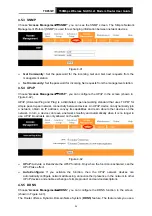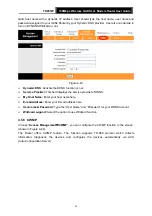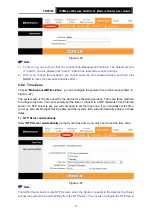
TD851W
150Mbps Wireless N ADSL2+ Modem Router User Guide
42
•
Source MAC & IP & Mask & Port Range:
Enter the IP information about the Source
host for the rule.
•
Protocol ID:
Select one among TCP/UDP, TCP, UDP or ICMP protocols for the
application.
•
Vlan ID Range:
Enter the Vlan range, and the rule will be effective to the selected Vlans.
•
IPP/DS Field:
Select the type of the action to assign the priority.
When you select IPP/TOS, you can assign the priority via IP information. IP QoS function
is intended to deliver guaranteed as well as differentiated Internet services by giving
network resource and usage control to the Network operator.
•
IP Precedence Range:
Enter the IP precedence range that the Router takes to
differentiate the traffic.
•
Type of Service:
Select the type of service that the Router takes to deal with the traffic.
•
DSCP Range:
Enter the range for the rule.
When you select DSCP, you can assign the priority via DHCP (the header of IP group). It
maps the IP group into corresponding service class.
•
802.1p:
Select the priority range for the rule.
¾
Action:
Configure the action that the Router takes to deal with the traffic which accord with
the rule.
•
IPP/DS Field:
Select the type for the action.
•
IP Precedence Remarking:
Select the number to remark the priority for IP precedence.
•
Type of Service Remarking:
Select the type to remark the service.
•
DSCP Remarking:
Enter the number to remark the DSCP priority.
•
802.1p Remarking:
Select the type to remark the 802.1p priority.
•
Queue:
Select the priority type for the action.
4.4.5 VLAN
Choose “
Advanced Setup
→
VLAN
”, you can activate the VLAN function in the next screen.
Virtual LAN (VLAN) is a group of devices on one or more LANs that are configured so that they
can communicate as if they were attached to the same LAN, when in fact they are located on a
number of different LAN segments. Because VLANs are based on logical instead of physical
connections, it is very flexible for user/host management, bandwidth allocation and resource
optimization. There are two types of VLAN as follows:
1)
Port-Based VLAN:
Each physical switch port is configured with an access list specifying
membership in a set of VLANs.
2)
ATM VLAN:
Using LAN Emulation (LANE) protocol to map Ethernet packets into ATM
cells and deliver them to their destination by converting an Ethernet MAC address into an
ATM address.
















































